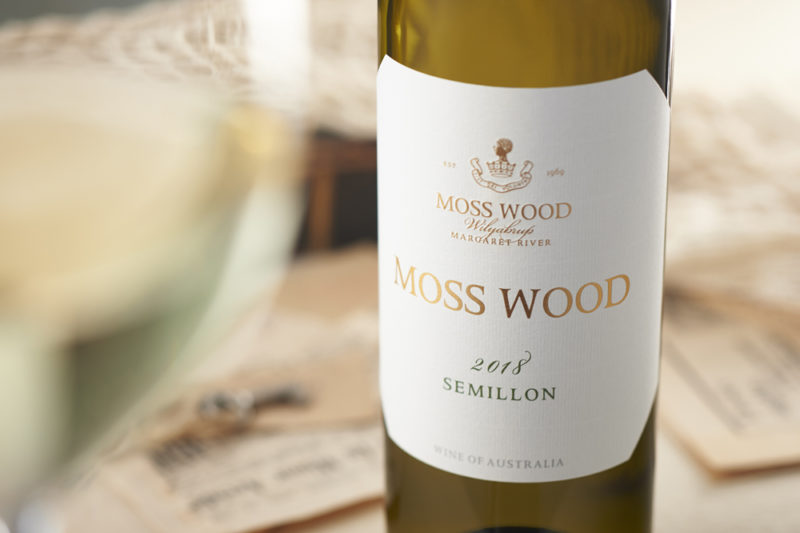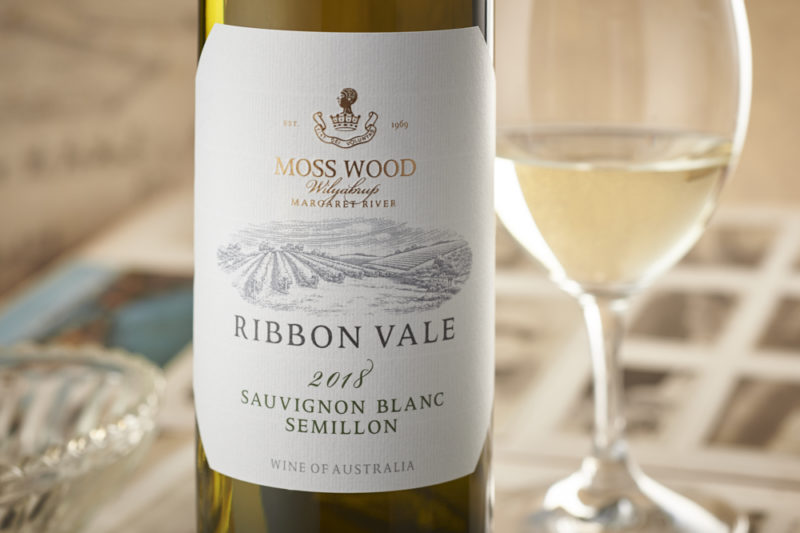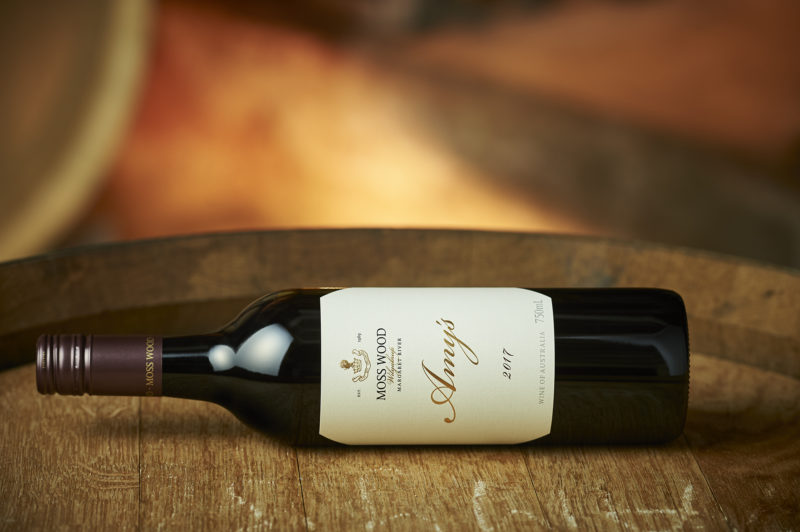MOSS WOOD NEWSLETTER THIRD SPRING NEWS ISSUE #101 NOVEMBER 2018
MOSS WOOD 2018 SEMILLON
MOSS WOOD RIBBON VALE 2018 SAUVIGNON BLANC SEMILLON
MOSS WOOD 2017 AMY’S
Moss Wood 2018 Semillon

VINTAGE NOTES
By virtue of its maritime climate, Margaret River has fairly consistent conditions from one year to the next. However, if we taste a range of vintages, it’s possible to see they are not exactly the same and we get small variations in style and fruit intensity. Generally speaking, we prefer warmer conditions because in that same lineup of vintages, it’s almost certain the hotter years will look the best. The easiest way to illustrate this is to taste each of the wines we made in the 2006 and 2007 years and we’d be London to a brick the latter would be preferred.
Looking at the white varieties, this is almost counter intuitive, because our region is not considered cold. Therefore, Chardonnay, Semillon and Sauvignon Blanc might be expected to show their brightest and most delicate characters in cooler years. Nevertheless, the fact is they all look a bit on the green side unless we’ve had a warmer summer. Our best guess is the general lack of extreme heat is the key and is one of the reasons why we log the temperatures above 33°C as a guide to likely fruit ripeness.
Considering all the above, readers won’t be surprised to learn that after our relatively cool and wet 2016/17 growing season, we were pleased to enjoy a more normal year in 2017/18. For an unirrigated vineyard like Moss Wood, we could hardly have asked for better. Rainfall of 1117mm was up for the year by 10%, providing plenty of soil moisture for the vines to cope with the yield of 8.90 tonnes/hectare. This was down slightly (12%) and probably the result of a day of rain and cool temperatures right at the end of flowering.
Glorious conditions were the order of the day during the period from flowering to harvest. In the end, the Semillon racked up 1140 hours between 18 and 28°C, well above our desired minimum of 1050, plenty of sunlight and warmth to keep them photosynthesizing and ripening the crop. There was very little in the way of extreme heat, with only 13 hours above 33°C and in the context mentioned above, we had to pick the fruit a little riper than average to get full flavour. In 2018 we picked at 14.1° Baume, notably higher than the average of 12.7°. The actual harvest date was only 4 days later than average on 14thMarch but this gave a total of 119 days from flowering to harvest, 11 days longer than normal, confirming the need for more time on the vine in cooler years.
The fruit was in terrific condition, with no disease or bird damage.
Wine Facts
| Ripening Time from Flowering to Harvest |
119 days |
| Median Harvest: | 14/03/2018 |
| Bottled: | 10/07/2018 |
| Released: | 08/11/2018 |
| Yield: | 8.90 t/ha |
| Baume: | 14.1⁰ Baume |
| Alcohol: | 14% |
TASTING NOTES
Colour and condition: There is a medium to deep straw colour, with green tints and the wine is in bright condition.
Nose: An absolutely classic Semillon combination of green apples and figs but with the added complexity of stewed pears and cinnamon. As always, there’s a touch of earthiness suggesting barrel aging but this is definitely not the case.
Palate: In the mouth there is a rich mouthfeel, not always a feature in young Semillons. The fig and pear fruit flavours combine with full body to smooth out the acidity and tannins, so necessary for cellaring but this year sitting nicely in the background. The net result is good length and drinkability.
PRODUCTION NOTES
One of the defining and beautiful parts to making Semillon is the simplicity of technique. After picking by hand, the bunches were sorted for unwanted contaminants like leaves and stems and then put straight into the presses. The pressed juice was sent to stainless steel tanks, where it was settled for 48 hours and 10°C. Clear juice was racked to a second stainless steel tank where fermentation was carried out by multiple yeast strains and controlled to a temperature of 18°C. After fermentation was completed, the wine was immediately prepared for bottling and was fined with bentonite, for protein stability but needed no other fining. It was then sterile filtered and bottled on 5th July, 2018.
Our intent is to maximise the retention of the young fruit aromas then get the wine quickly in to bottle to capture these and then allow the cellaring process to build the complexity.
CELLARING NOTES
With all this delicious stuff going on, the 2018 Semillon will certainly tempt people to consume it now and frankly, it is indeed a very consumable youngster. However, we have our normal aging expectations and would recommend it be kept for at least a decade, to see the butter and toast complexity begin to emerge on the nose and to see some further softening of the palate. For those who enjoy classic, complex Semillon they will need to wait at least another decade after that to see the wine at full maturity.
Moss Wood Ribbon Vale 2018 Sauvignon Blanc Semillon

VINTAGE NOTES
Just as Moss Wood Semillon reveled in the good 2017/18 growing season, so did Ribbon Vale Sauvignon and Semillon. The numbers give a clear picture of just how good things were. Sauvignon Blanc was picked at 11.2° Baume on 21st February, 5 days earlier than average, with a yield of 14 tonnes per hectare. The Semillon came off on15th March at 13.5° Baume with a yield of 11.5 tonnes per hectare, a very handy 10% above average. Flavours, ripeness and yields were virtually exactly where we want them. How much of this was skill and how much was luck will be up to others to debate and we’ll leave readers to draw their own conclusions. Naturally, we at Moss Wood reckon it’s the former!
Wine Facts
Ripening Time from Flowering to Harvest
Sauvignon Blanc – 96 days
Semillon – 118 days
Median Harvest Dates:
Sauvignon Blanc – 21/02/2018
Semillon – 15/02/2018
Bottled: 10/07/2018
Released: 08/11/2018
Yield:
Sauvignon Blanc – 13.97 t/ha
Semillon – 11.47 t/ha
Baume:
Sauvignon Blanc – 11.2° Be
Semillon – 13.5° Be
Alcohol: 12.5%
TASTING NOTES
Colour and condition: The hue is light to medium straw with green tints. Condition is bright.
Nose: A lifted and zesty aroma combination of leaf, gooseberry and citrus of Sauvignon Blanc, combining with a nice addition of lemon sherbet and fig from the Semillon. There are also some nice bread dough-like notes underneath, a product of the barrel fermentation.
Palate: Here the theme of freshness continues, with a zesty leaf and citrus fruit depth, lifted by crisp acidity. Mouthfeel is medium bodied and the texture is nicely rounded, with a touch of bread dough. The finish is clean, with no lingering tannin or bitterness.
PRODUCTION NOTES
Having raw material of this quality meant that in the winery our aim was to make sure we got it safely in to bottle. For both varieties, the hand-picked fruit was whole bunch pressed and the juice was settled in stainless tank. The clear juice was racked to stainless steel, fermentation was commenced with multiple yeast strains and after 4 days, the must was racked to barrels. All were 228 litre French barriques but none were new, because we are only seeking the textural improvement rather than oak character.
After fermentation was completed, all the barrels were racked to stainless steel, with final blend being 74% Sauvignon Blanc and 26% Semillon.
Fining trials were then carried out and the wine was treated only with bentonite for protein stability. The balance of the wine was excellent and no improvement was found using the proteinaceous agents, egg white or skim milk. It was then sterile filtered and bottled on 6thJuly, 2018.
CELLARING NOTES
With all this freshness, the 2018 Sauvignon Blanc Semillon is a difficult thing to resist and really, it should be drunk young, when these characters are so much to the fore. Nevertheless, for those who want to see some softening of the palate and a little more caramel-like complexity on the nose, we recommend at least 5 years aging.
MOSS WOOD 2017 AMY'S

Wine Facts
Median Harvest Dates:
Glenmore Cabernet Sauvignon – 24th April, 2017
Glenmore Merlot – 11th April, 2017
Glenmore Malbec – 12th April, 2017
Petit Verdot – 11th April, 2017
Bottled: 10/07/2018
Released: 08/11/2018
Baume:
Glenmore Cabernet Sauvignon – 13.3° Baume
Glenmore Merlot – 14.0° Baume
Glenmore Malbec – 13.6° Baume
Glenmore Petit Verdot – 14.7° Baume
Alcohol: 13.5%
TASTING NOTES
Colour and condition:
Very deep brick red hue, almost blue tints, in bright condition.
Nose:
The theme of the nose is ripe berries, with all the typical features of the 4 varieties in the blend – red current from Cabernet Sauvignon, blackberry from Merlot, plums and spices from Malbec and black jubes and musk from Petit Verdot.
Palate:
In the same mould as the nose, the palate has great fruit concentration and length, courtesy of all the dark berry flavours. This sits over and all but covers a firm structure of acid and tannin, so the result is very drinkable.
Production NOTES
Across all the varieties in the Amy’s blend, we use a similar technique, with fermentations in closed tanks, with pump-overs for colour and flavour extraction. Time on skins is typically shorter than the Moss Wood and Ribbon Vale reds, varying from 9 days for the Petit Verdot to 16 days for the Cabernet Sauvignon, Malbec and Merlot. After pressing, the wine was blended and then racked to 228 litre French oak barrels, although there was no new oak. Our intention is to ensure the Amy’s always has good fruit depth and so a short time in old barrels gives us sufficient complexity.
In June 2018 all barrels were racked and blended in stainless steel and assessed for tannin balance.
Fining trials showed the wine to have excellent balance and so it remained untreated. It was then sterile filtered and bottled on 9th July, 2018.
The final blend is 79% Cabernet Sauvignon, 10% Merlot, 7% Malbec and 4% Petit Verdot.
CELLARING NOTES
We noted above our plan for this wine which is for it to be balanced and drinkable as a youngster and we are very confident we’ve hit the mark with the 2017. However, as everyone now knows, high quality Margaret River Cabernet Sauvignon is a fine cellaring wine and for those who like to have some cedary and tarry complexity, we recommend cellaring for 10 years.
VINTAGE NOTES
The discussion of Amy’s begins with an apology. This wine has had very little airplay from us since the 2014 vintage and we feel we owe an explanation. It’s role in our portfolio is to introduce Moss Wood to new customers and which means it is sold quite widely across the wine trade in restaurants and liquor stores. Extensive distribution is very important but puts considerable pressure on our supplies, despite Amy’s being the biggest volume of wine we make. It so happens that yields in 2015 and 2016 were very low and therefore our quantities were well below average and both wines worked their way through our system unusually quickly and both without a newsletter to our Members. We simply couldn’t keep up and we trust we haven’t offended too many people.
With the 2017 vintage, yields were back to normal, Amy’s is back in our newsletter and our first red wine release from the 2017 vintage, one that was both exciting and challenging. Regular readers will recall its uncanny similarity with the great 1990 and from a quality perspective, 2017 looms as a significant competitor for its older sibling. If we look at the harvest details, we can see why this was.
The exciting part is in the consistency of the ripeness across all varieties. This is very important because our aim in making the Amy’s is to ensure the wine has good fruit depth, without an assertive structure. Each variety was picked over 13° Baume and the Merlot and Petit Verdot both got to 14°. This means they all have genuine fruit richness, leaving the tannins, even in the young wine, sitting nicely in the background.
So, what was the challenge? The harvest dates, of course! Instead of starting in mid-march with Malbec or Merlot, we didn’t take any fruit until 11th April. Cabernet Sauvignon has a median harvest date of 24th April but the last batch didn’t come off until the 29th! In a region where significant rain is always a risk from the middle of March onwards, this was indeed a challenge. We spent many hours assessing and reassessing the weather forecasts and we got lucky. Mother Nature decided to give us a classic west coast, Indian Summer, with no rain and balmy autumn days. Every day the forecast said fine was another day that we would delay picking and, in the end, the result is quite special.
Order
OUR WINES:
Contact
MOSS WOOD:
Location: 926 Metricup Road, Wilyabrup WA
Postal: PO Box 225, Cowaramup WA 6284
Phone: +61 8 9755 6266
Fax: +61 8 9755 6303
Follow us on
SOCIAL MEDIA:
